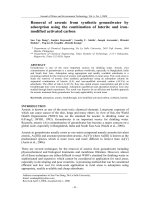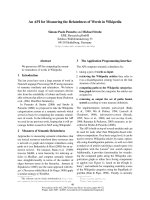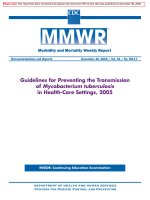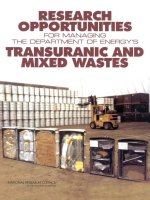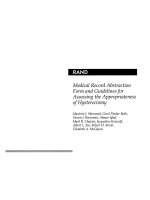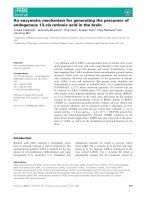Equipment for using the sonochemistry into the fattening of pigs
Bạn đang xem bản rút gọn của tài liệu. Xem và tải ngay bản đầy đủ của tài liệu tại đây (489.69 KB, 5 trang )
ISSN: 2277-3754
ISO 9001:2008 Certified
International Journal of Engineering and Innovative Technology (IJEIT)
Volume 3, Issue 5, November 2013
380
Abstract—The article deals with the use of activated water for
drinking of pigs. Moreover, is described a method sonochemical
activation of water. Sonochemical activated water is devoid of own
supramolecular structure and has a high solvent power similar to
how a boiling water, while remaining virtually the same
temperature, which was prior to treatment. It is shown that the
water in a thermodynamically no equilibrium state, in which
abideth some time as a result of such treatment, and has
bactericidal and bacteriostatic properties, which it retains long
time. All this suggests that the hydration of biopolymers directly
into the esophagus and stomach of animals during their drinking
will give tangible effect. Given the description of the mechanisms
of cavitational disintegrated of water and described in comparison
reactors for water treatment. Said that a regulatory authority in
Russia give permission to use sonochemical technologies and
devices in the food industry. Described sonochemical reactor,
designed specifically for use in drinking of pigs, which have a
reduced noise level and power consumption, but with better
performance.
Index Terms—Hydration and Structuration of Biopolymers,
Non-Stationary Thermodynamically State of the Water,
Sonochemistry, Sonochemical Cavitation Reactor.
I. INTRODUCTION
Water plays an important role when the fattening pigs.
Water used for both sanitary and technological needs, and
directly for drinking pigs. Plentiful drink need especially
when fatten with dry foods [1,2]. As equipment are use nipple
drinkers. In fattening complexes where there are sources of
groundwater, they are attached to the network of water tower
or directly to the network of installation for lifting water from
wells. In the period of snow break or heavy precipitation as
rain contaminated surface water can get into the water fed to
animals. [3] Use of contaminated water can lead to the spread
of infectious diseases among animals. Therefore, a special
water treatment before its supply from the mains to the
animals is need.
The use of activated in different ways drinking water for
animals is well known. Activation are doing not only for the
water treatment and disinfection, but also for increase the
weight gain of the animals [3,4]. In conducting joint
Russian-Belarusian Studies in Food sonochemistry [5],
there was an interesting idea to apply sonochemical
activated water for intensive hydration of biopolymers pigs
feeds. It has been hypothesized that it could be applied when
pigs has drinking. Then hydration will have place directly
into the esophagus and stomach of animals. Prepared for this
water should be supplied in drinking bowls for pigs which,
for example, were designed and manufactured in the
Republic of Belarus company "Demeter". It was decided to
equip them with special sonochemical reactors. The
combination of feeding dry food with watering of
sonochemical treated water will allow to the pigs better
absorb food and increase weight gain. Thus, in the article [3]
at the daily consumption of treated water cavitations larger
than usual, weight gain increased by 6.5%. In this case, the
consumption of specific energy for water treatment amounted
to 34.4 kW
h/t. The idea was supported by the Academician P.
Vityaz of National Academy of Sciences. Under his
leadership, the regional office of the Russian Acoustical
Society developed a special sonochemical reactor [6].
II. SUBJECT OF SONOCHEMISTRY
Sonochemistry are high-energy chemistry. Nowadays,
regarding sonochemistry, including the food processing
industry and in agriculture, is held active research worldwide.
Studies have begun and in the Moscow State University of
Technology and Management (MSUTM) after the
organization of it in 2009, the laboratory of food
sonochemistry. This allowed him to stand on a par with the
world's leading educational institutions - universities,
Coventry, Illinois, Hohenheim, Melbourne and Mexico City.
Was performed a sanitary-epidemiological examination and
certification of designed in university the cavitation reactors
by TU 5130-002-26784341-08 for implement of them into the
sonochemical technology of food industry [7]. Federal Service
for Supervision of Consumer Rights Protection and Human
Welfare and State Standard of Russian the reactors are allowed
to produce for use in the technological devices of food industry.
These reactors (Fig. 1) allow us to replenish incurred of
moisture losses on the stages of storage and transport of food
raw material particularly in the dried and froze. It is believed
that the pure protein can theoretically bind in the hydration
reaction of up to 40% of the water of its weight. [8].
The main factor of the sonochemical reactions is a
cavitation in the liquid at which generates giant impulses of
pressure generated by the cavitation bubbles. Since the total
amount of contents of bubbles, compared to the volume of the
liquid is negligible, so that sonochemical reactions is
occurring in the gas phase inside the bubbles have little
practical importance. Practically significant sonochemical
reactions is occur in the liquid phase as a result of distributing
therein of the pressure pulses from the bubbles, stimulating
the reaction of solutes through a mechanical impact on the
structure of their hydrate shell and the most water. The
thermal dissociation of water which going in the gas phase
bubbles results in only a slight shift of pH to the alkaline
Equipment for Using the Sonochemistry into the
Fattening of Pigs
T. Shlenskaya, T. Baulina, O. Krasulya, S. Shestakov
Moscow state University of Technologies and Management, Russia
ISSN: 2277-3754
ISO 9001:2008 Certified
International Journal of Engineering and Innovative Technology (IJEIT)
Volume 3, Issue 5, November 2013
381
region, and the synthesis of hydrogen peroxide in amounts of
thousandths units on the weight of water. Therefore, water for
drinking of pigs not necessary to protect from education in her
structure radicals and peroxide compounds, as is done in the
food sonochemistry, since they are bactericidal agents. This
makes it possible exception of chlorine, which commonly
used to disinfect water. Food safety sonochemical water
treatment has been studied experimentally. This was
determined by biotesting by methodics the toxicological
assessment of food products [9]. Was compared the number
of ciliates Tetrahymena pyriformis in samples of spray drying
serum which was restored on sonochemical treated water at
regular intervals. In the serum of restored at the water which
was subjected cavitation process throughout the experiment
the number of ciliates was higher than in the serum, the
recovered on normal water. And, moreover, the increase
amount of their with time there prevail also. This is because
the cavitation treatment significantly alters the
physicochemical properties of the water and not creates the
factors adversely affecting the growth and reproduction of
protozoa. The whey the better soluble in such water and the
nutritional value of the solution turns above. It also emerged
that arise and is good saved the bacteriostatic properties of the
treated water.
Time after
5 min treatment
with
Absolute
viscosity, cPs
Viable
microorganisms
by the test [10]
Two hours
24 hours
0.9710.008
0.9870.004
0.630
0.849
Control of
1.0190.007
1.760
Fig. 1. Exterior and interior view installation sonochemical
processing of salt brines for the cooking of meat food
products with the reactor by TU 5130-002-26784341-08
(circled in red).
The transformation of the energy of pressure pulses of the
cavitation in the water epithermal implements the mechanism
of destruction of hydration shells of ions and colloids
dissolved substances that prevent their entry into chemical
reactions. Therefore cavitation easily turn a soluble calcium
bicarbonate Са(HCO
3
)
2
and Mg(HCO
3
)
2
into form insoluble
amorphous colloidal CaCO
3
, and MgCO
3
, what doing
softening water [11]. Water even at room temperature has an
associative supramolecular structure [12] (Fig. 2).
Fig. 2. The structure of water molecules (left) and a
fragment of an associative water structure (right).
Covalent bonds are marked with red and hydrogen bonds –
green.
Under the influence of cavitation pulses pressure the water
on time acquires thermodynamically non-equilibrium state,
which is characterized by its anomalously high solvent ability
(Fig. 3). It lasts until the received energy gradually will be
returned in the form of heat of hydration, which occurs
between the water molecules, again restoring the hydrogen
bond and structure of water that correspond to
thermodynamic equilibrium. That is, over time, inevitably
occurs the relaxation of the non-equilibrium state.
A
n
N
mn
OHmOHOHOH
25)(
2222
kJ (1)
Where: m – the number of molecular water associates that
react; n – number of water molecules that consist in an
associating; NA – Avogadro's number.
If immediately after the cavitation in the water dissolve the
dry biomass, then dissolved in it electrolytes almost
completely dissociated on the ions which will be immobilized
of the water monomolecules and the protein molecules
acquire dense hydrated shells. This will increase the mass of
the protein, since the water connect to it through the
mechanisms similar to those that occur in nature in the process
of it synthesis and almost also strong, how a ties which form a
natural protein structure.
Fig. 3. The destruction of the molecular associates of water
by pressure pulse from the cavitation bubble. The arrow
indicates the direction move of the pulse.
ISSN: 2277-3754
ISO 9001:2008 Certified
International Journal of Engineering and Innovative Technology (IJEIT)
Volume 3, Issue 5, November 2013
382
In addition, may arising, the quaternary structure of the
protein (Fig. 4) formed by the so-called the structuring by
hydration [13].
Fig. 4. Hydration and structuring of protein by hydration.
Water molecules which are hydrated of the active centers
of amino acids of the protein are shaded.
But the energy of cavitation is the cause of erosional
destruction of solid materials [13]. Erosion may be subject
and the materials used for the components of the cavitations
reactors design - the enclosure and acoustic cell. Products
erosion, falling into the treated water, can irreversibly change
its physical and chemical properties, what is strictly not
allowed for treating of drinking water.
III. INFORMATION ABOUT REACTORS FOR
WATER TREATING
This deficiency is not in the reactor, specifically designed
for watering pigs [3], where acoustic cell has two opposite
and working in one phase a membrane transducers. That is
them radiating surfaces doing into liquid the fluctuation in
opposite directions (Fig. 5).
Fig. 5. Design of reactor from [3]. In the plane of the
section the tonal pattern shows a distribution of the bulk
density of the erosive power of cavitation.
They are spaced apart by one-half wavelength of
ultrasound in water, and the side wall of the housing is located
near the node of the flexural vibration of the radiating
membrane. Therefore, its erosion is negligible. Such a reactor
has a large volume of the working chamber, but its specific
productivity is not very high. In it used a magnetostrictive
method of electro acoustic conversion with efficiency about
50%. In addition, he has a big noise emission, as
magnetostrictive transducers are cooled with water, in which
also acts cavitation, which is not desirable for pigs [14]. It is
installed as stated in its description on the water tank for 25
pigs. And when comes the maximum daily water consumption
it will provide only half of the water needs, even if it is
included in the recirculation circuit of storage tank.
IV. HYPOTHESIS
If considering the volume of the liquid in the reactor,
enclosed between the planes of the solid-state resonator, from
of which occurs spread fluctuations, as part of the vibration
system of acoustic reactor cell, then you can create the
optimum conditions for the superposition of these
fluctuations. Under such conditions the areas of cavitation,
which are formed near the antinodes of the pressure resulting
wave, will occupy the largest volume [7], what will make the
reactor more productive. This can be done, given the
well-known fact that the elastic plane wave in water is capable
of produce the cavitation energy at a distance of no more than
three half-waves, as well as that on distance of length of the
half-wave oscillations in the metals may take place about a
three half-wave oscillations of the same frequency in the
liquid. That is, the working length of acoustic cell of the reactor
should be equal to 1.5 wavelength of the elastic oscillations of
the liquid when the radiating surfaces are spaced apart on 0.5
oscillation wavelength of the metal. Then height of acoustic cell
must be exactly equal to half the oscillation wavelength of the
metal at the same frequency. Such conditions are easier to
perform, when the solid-state part of the vibrating system
acoustic cell is symmetrical about the center of mass, i.e., when
the transducers are located on both sides of the treated water. In
addition, in geometrically symmetrical about its center of
mass system of elastic waves would be better hold resonance.
Cavitation erosion radiating surfaces wherein are practically
not. The surface of the reactor vessel, optimally choosing its
diameter, can be placed in the erosion-safe area. A
interconnecting the two emitting surface of a solid-state
resonator element (jumper), you can protect against cavitation
thin erosion-resistants coated, such as rubber or plastic. The
effect of this decision is to increase the dissipated power in the
acoustic cavitation and increasing processing performance
without increasing the erosion of its surfaces and without
increasing the intensity of the external noise.
V. THEORY AND COMPUTER EXPERIMENT
A comparison was made such reactor with the reactor from
[3]. The comparison was performed by computer simulation
with via mathematical model of the cavitation reactor and the
similarity principle cavitational processes [15]. As a reference,
was selected the reactor from [16] (Fig. 6).
It consists of a camera body of the seamless stainless steel
pipe. Acoustical transformers, which transmit vibrations into
the water from piezoelectric transducer electrical output of
ISSN: 2277-3754
ISO 9001:2008 Certified
International Journal of Engineering and Innovative Technology (IJEIT)
Volume 3, Issue 5, November 2013
383
1.2 kW secured therein by the flanges bolts and nuts. Through
the working volume of the reactor water passes through the
nozzles.
Fig. 6. The design of the reactor from [16]
Designed reactor (Fig. 7) consists of a camera body with
flanges. In it using bolts and nuts fastened acoustic waveguide
transformers which transmit vibrations of piezoceramic
transducer electrical output of 1.2 kW into the water. Both
transformers are interconnected into the single solid-state
symmetrical vibrational system. A source power fluctuation,
the maximum pressure amplitude total wave is the same as that
of the reactor from [16].
Fig. 7. The design of the developed reactor with a
monolithic solid-state vibrational system of the resonance
cell.
When compared was modeled of the performance of the
reactor, which was calculated as the product of the integral in
the working volume of reactor, V the density of the erosive
power of cavitation:
,ddd
)(
}{}{
)(
2
2
22
V
i
yxvafQ
(2)
where: f – oscillation frequency; a – average attenuation
coefficient of the total pressure perturbation from the all
bubbles in the design point; v
i
= S
h
i
,
i = 0…n – total
volume of cavitation fields (S - area of the radiating surface
fluctuations); – the average dimensionless time the arrival
of pressure disturbances from all the bubbles in the design
point;
]
2
[
2
1 n
n
– an amendment on phase of the cavitation
area [15]; in square brackets whole part, and in curly braces -
the fractional part of the number. The mean mileage of the
pressure perturbation of cavitation in the period of the
harmonic wave is set equal to the length of this wave.
Dimensions h
i
cavitation regions along the line of the waves
were calculated in angular units of phase as the difference
between the values of the even and odd positive roots of the
transcendental equation:
,0])1()1[(sin
0
222
max
AA
n
(3)
where А
max
, А
0
– the maximum at the emission of vibrations in
the half-space of the liquid and threshold of cavitation for the
amplitude of the sound pressure of wave; – cavitational
scattering coefficient of wave energy. В линейные единицы
они переводились делением на волновое число. Эрозия
(загрязнение воды ее продуктами) вычислялась
пропорционально интегральному значению объемной
плотности эрозионной мощности на контактирующих с
водой металлических поверхностях реакторов.
Результаты сравнения в значениях по отношению к
эталону показаны в таблице:
In the linear units they are transformed by means of dividing
at the wave number 2. Erosion (pollution of water by
erosion products) was calculated how the integral value of the
bulk density of the erosive power in water near the metal
surfaces of the reactor. The comparison in the values relative
to the reactor on Fig. 6 shown below:
REACTOR
INDEX
Fig.5
Fig. 6
Fig. 7
The electric power, kW
8,0
2,4
2,4
Performance of water
treatment, m
3
/h
0,4
0,4
0,9
Relative erosion, rel.u
2,7
1
2,2
VI. DISCUSSION OF EXPERIMENT AND CONCLUSIONS
The table shows that the reactor in Fig. 5 has in 2.25 times
performance of water treatment smaller than the reactor in Fig.
7 and higher erosion of construction details. It is understood
that the reactor in Fig. 7, since the processing performance
higher, that contaminating water by products erosion (by metal
ions) is less than unity. This reactor at complex for fattening
pigs can be included in the recirculation circuit of the storage
tank for water.
REFERENCES
[1] S. Alexandrov, E. Prokopenko Guide to feeding pigs. -
Moscow, Donetsk: AST Stolker, 2004.
[2] V. Kabanov Svinovodstvo. M: Kolos, 2001.
[3] N. Podkhomutov, V. Suchkov Water treatment using
ultrasound for watering animals in the unit of pig fattening //
Technology, equipment and components for the production of
meat products a healthy diet: Proc. Intern. Scientific-practical
workshop. - Vologda, "Gardening", 2004.
[4] A. Apalikov Productive qualities of young pigs at using an
activated water // Dissertation PhD, Samara, 2004.
[5] Shestakov S., Krasulya O., Smeshek E. Sonochemistry of food
- area high-energy chemistry which actively is researched now
in Russia and Belarus // Materials IX International
ISSN: 2277-3754
ISO 9001:2008 Certified
International Journal of Engineering and Innovative Technology (IJEIT)
Volume 3, Issue 5, November 2013
384
scientific-practical conference «Capabilities of modern science
- 2013». Chemistry and Chemical technology Praha:
Publishing House «Education and Science», 2013, pp 17-25
[6] Development of the technical proposal "A sonochemical
reactor for the preparation of water at hydration of biopolymers
dry feed pigs for their at watering": Report on experimental
design work / Russian Acoustical Society. Vologda regional
office, will teach. hands. P. Vityaz, performer E. Smeshek,
State No 01201367171, 2013
[7] S. Shestakov Food sonochemistry: the concept, the theoretical
aspects and practical applications Saarbruecken: LAMBERT
Academic Publishing, 2012.
[8] The water in food products / Ed. R. Duckworth. Moscow: Food
Industry, 1980.
[9] Е. Cheremnyh, Е. Simbireva the ciliates are tasting to food //
Chemistry and Life, 1, 2009.
[10] A. Stekhin, G. Yakovleva A structured water. Nonlinear
effects Moscow: LCI Publisher, 2008.
[11] N. Tikhomirov etc. A method of reducing temporary hardness
of water in the stream and cavitation reactor for its
implementation // Patent RU 2422371, C02F 1/36.
[12] Jinesh K.B., Frenken J. W.M. Experimental evidence for ice
formation at room temperature // Physical Review Letters, 101,
2008, 036101.
[13] S. Shestakov The basic technology of cavitation
disintegration Moscow: EVA-Press, 2001.
[14] N. Bazanova et al. Physiology of agricultural
animals Moscow: Kolos, 1980.
[15] С. Shestakov Multibubble acoustic cavitation: A mathematical
model and a physical similarity // Electronic Journal "Technical
Acoustics», , 2010, 14.
[16] Development of the technical proposal "A cavitation reactor
for the sonochemical water treatment and preparation of water
and aqueous solutions for hydratation of various substances "
Report on experimental design work / Russian Acoustical
Society. Vologda regional office. State No 01201254896,
2012.
AUTHOR BIOGRAPHY
Tatiana Shlenskaya - doctor of technical
sciences, professor, head of the Institute of
Technological Management in MSUTM.
Research interests: technology of food
processing, a products functional, specialized
purpose, catering. Author of 25 books,
monographs and textbooks, more than 150
scientific articles in leading national and
international journals, 33 inventions.
Tamara Baulina - PhD in biological sciences,
associate professor in MSUTM, deputy head of
the department of scientific work. Research
interests: the technology of functional foods,
the development of technology products with
non-traditional herbal supplements, technical
microbiology. Author of one book and more
than 100 scientific publications in Russian and
foreign journals. Has 5 of patented inventions.
Olga Krasulya - doctor of Technical Sciences,
professor at MSUTM named KG Razumovsky.
Research interests include: technology of meat
processing, modeling formulations, development
of automated expert systems, applied
sonochemistry author of three books, 120 articles
in industry magazines, 12 patented inventions.
Sergey Shestakov - doctor of Technical Sciences,
professor of MSUTM, Chairman of regional branch
of the Russian Acoustical Society. Research
interests: Systems analysis and mathematical
modeling in the field of ultrasound technology and
sonochemistry. Is author of scientific discovery in
the field of physics, a four books, over one hundred
scientific papers, has 12 registered software
products, 65 inventions.
